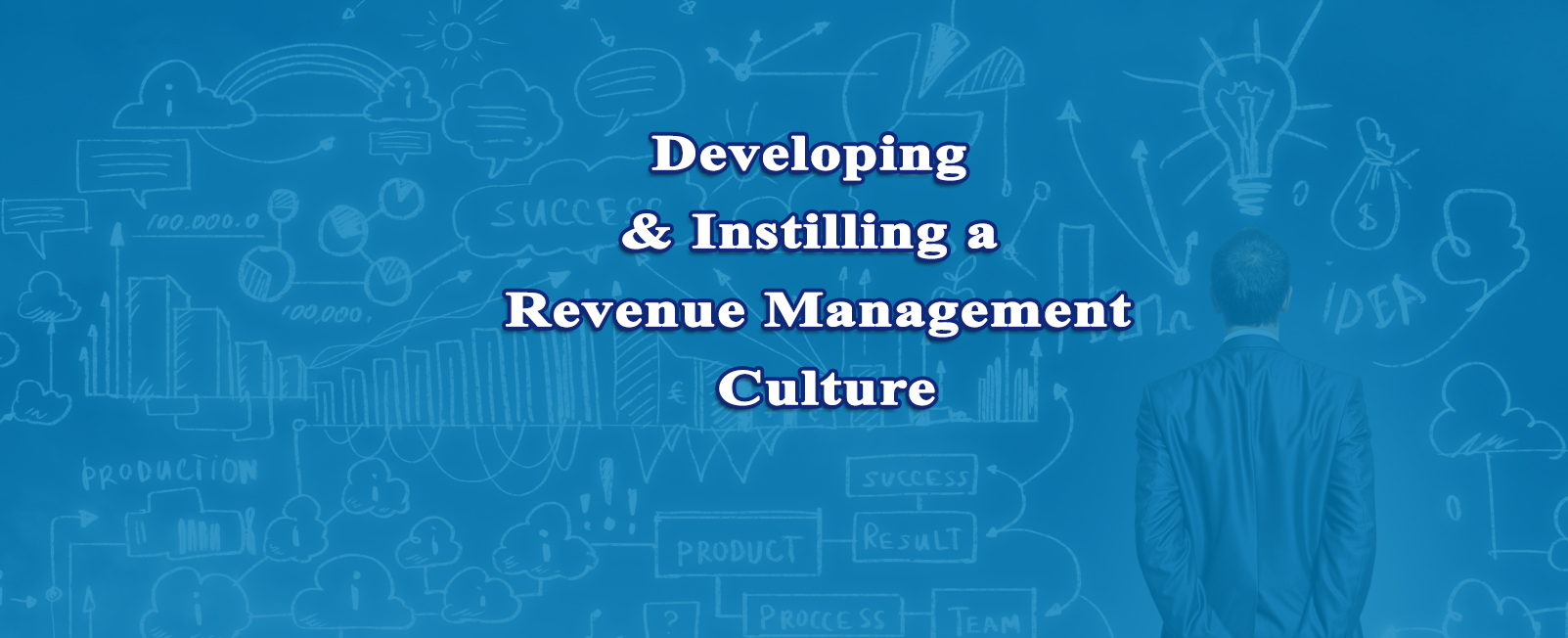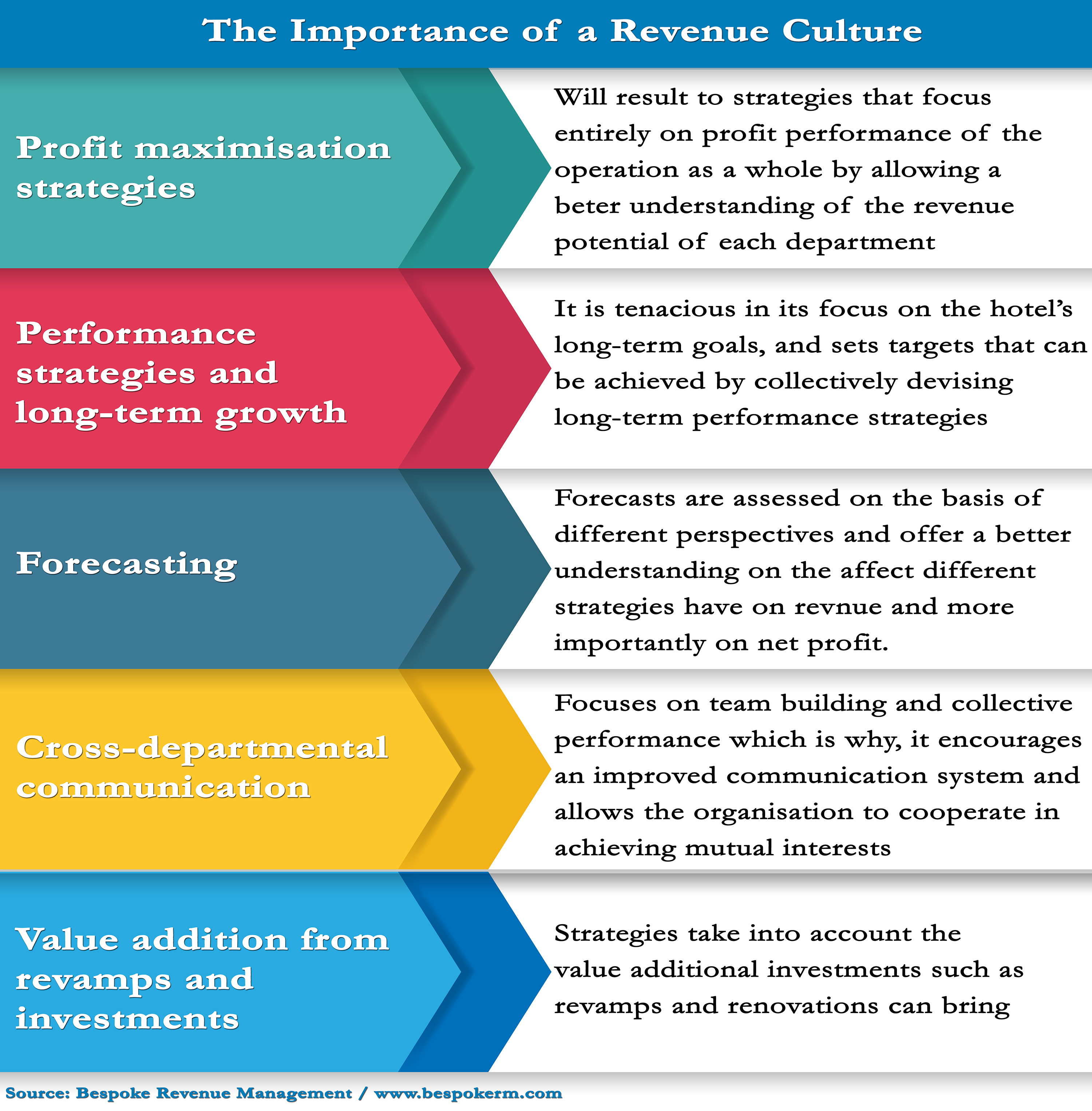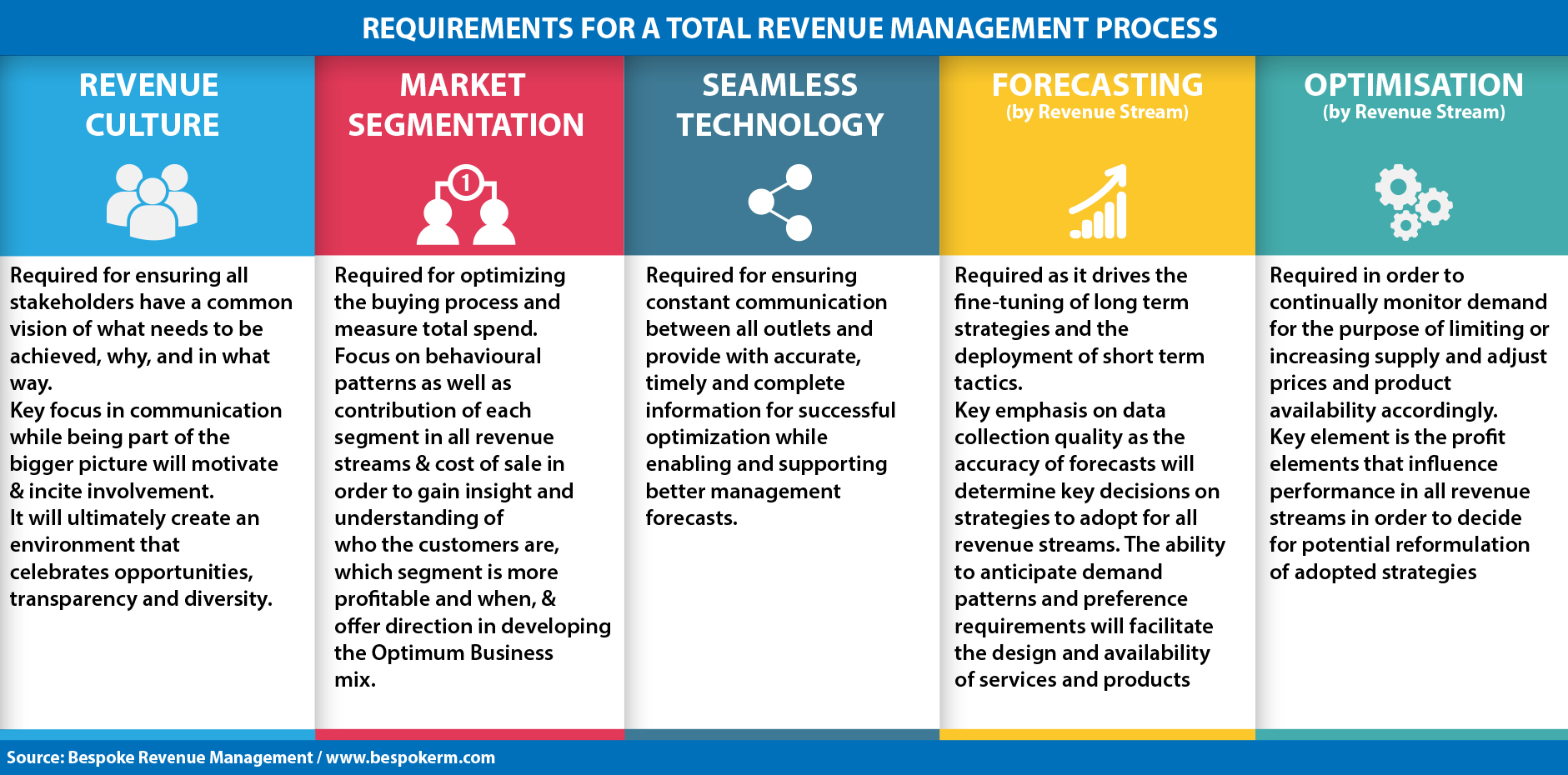
In a recent article we discussed Total Revenue Management, a concept that should be implemented as a business philosophy and strategy as its principles take into account the entire operation. Total Revenue Management, (TRM), comprises both strategical and tactical procedures and aims to identify & optimize the customer journey (you can read the full article on Total Revenue management here: https://goo.gl/9ri1ED).
The success of a TRM process depends on not only the main objectives that a hotel or hotel company aims to achieve, but also the route it plans to take and move on to lead towards accomplishing those. The ideal route to maximize profit by adapting a TRM approach is through developing and instilling a revenue culture. A coherent revenue strategy is more than just systems, demand forecasting and constant price adjustments. It is a business philosophy and strategy that when taken into account in all departmental procedures can result in increased revenue & profit performance.
A revenue culture implies that all participants have a common vision of what needs to be achieved, why, and how. By having a clear understanding of what the organization stands for, and the strategies and tactics it employs to reach set targets, one will find it easier to define standards of performance, and establish expectations. Whilst not everyone will ultimately be responsible for achieving what is required, it is essential that relevant stakeholders participate in the discussions and everyone is aware of the decisions taken. This will improve cross-departmental communication & engagement which are the key elements of a revenue culture and will ultimately foster collaboration and innovation.
Furthermore, having an overall view of the business will motivate and incite involvement, a factor that will give the team a sense of ownership. The implementation of a rigorous training program is mandatory to shape and instill the right mentality and guarantee long-term success. This will create an environment that celebrates opportunities, transparency, and diversity.
It is important to understand that no matter how well planned and executed a strategy is, it will not reach its full performance potential unless it is aligned with the overall culture. The best strategies will not work in isolation especially if they cause conflict to targets or plans of other departments. This is something we have seen very often in a number of hotels we have worked with where inconsistent strategies can lead to profit loss & operational inefficiencies.
The Importance of a Revenue Culture

· Allows the formulation of profit maximisation strategies
Revenue management is a culture that needs to focus entirely on profit maximization of your hotel, which is the top priority in your set of targets. Developing & establishing such a culture will aid the development of your hotel’s profit maximization strategies. This will lead to strategies that focus entirely on profit performance of the operation as a whole by allowing a deeper dive in the revenue potential of each department.
· Allows to focus on performance strategies and long-term growth
Revenue management culture takes into perspective the broader spectrum of an organizations goals and targets. This is something the managers can deviate from since they become more focused on the short-termed, day-to-day goals that are more lucrative. A revenue culture incites the participation of all the stakeholders who are directly affected by the hotel’s decisions. It is therefore tenacious in its focus on the hotel’s long-term goals, and sets targets that can be achieved by collectively devising long-term performance strategies.
· Allows revenue management forecasts to take into account operational and financial forecasts
Operational forecasts of any hotel include cost estimations of resources needed such as staff, inventory etc. On the other hand, the financial forecasts are the estimates of the profitability that the organization would be able to achieve at a month’s end. Developing a revenue culture will allow forecasts to be assessed on the basis of three different perspectives and offer a better understanding on the affect that different strategies have on cross-departmental profits and more importantly on net profit.
Moreover, as requirements will include focus on overall profitability, current metrics will need to be re-evaluated to reflect that. While RevPAR (Revenue Per Available Room) will still play an important role, TrevPAR (Total Revenue Per Available Room) will need to be established to measure overall performance, while GOPPAR (Gross Operating Profit Per Available Room) should be adopted to measure profit. Calculating GOPPAR could prove challenging as different organisations place different cost elements before or after GOP. Therefore, a universal re-positioning in financial statements will be required for the adoption of this fundamental metric.
· Allows an organization to develop cross-departmental communication culture
Each of the departments has its own set of goals. Where a sales department is volume-driven and strives to accumulate as many customers as it can, the service department is chiefly concerned with the product quality to satisfy the customer. Similarly, all the other departments focus on their own goals. However, a revenue management culture focuses on team building and collective performance which is why, it encourages an improved communication system and allows the organization to cooperate in their operations to achieve mutual interests. This will eventually eliminate conflicting decisions taken in isolation and improve both financial and operational performance
· Allows the inclusion of value addition from revamps and investments
Strategies derived in an environment with a strong revenue culture are crucial for not only constructing profit maximizing strategies or cost budgeting, but also taking into account the value additional investments such as revamps and renovations to the hotel that can significantly raise the standard and quality of the service. This is important especially for operators looking to attract investors or potential franchisees.
Developing and Instilling a Revenue Management Culture
Objectives
An effective revenue culture is developed and instilled when the objectives are established by the top levels of the hierarchy and informed to the subordinates accordingly. This allows better communication amongst the top management, head of departments and employees at all levels of organizational hierarchy, bringing everyone aboard to work on aligned set of targets.
Planning
The next crucial step to developing and instilling a revenue management culture is through effective planning. Once the goals have been established, the next point of focus is execution of actions that would enable the organization to achieve those goals. This is why planning is imperative in order to devise successful strategies. Planning is also necessary to not only ensure that the right steps are taken to achieve the hotel’s targets and goals but also, to provide a source for measuring the concrete results and whether or not the strategies employed have remained successful.
Training
Training of the employees at all levels of hierarchy is the key to developing and instilling a revenue management culture. A revenue culture breeds successful business leaders because it trains the employees to communicate effectively. Training and focused group sessions that educate employees of different departments and different hierarchy levels allows them to understand the mutual objectives that they all are working to achieve, improving their productivity and output.
Technology
Technology is a resourceful way of developing and instilling a revenue management culture. Progress in big data has simplified the methods of acknowledging and measuring challenges, risks and opportunities by producing relevant dashboards and key indicators. This gives your hotel the valuable information it needs for example market response to pricing, demand, and revenue elasticity. Moreover, the organization also gets to receive valuable insights on the market segment that is the most profitable not only for your rooms operations but for the hotel as a whole. As a result, your hotel can devise and develop more informed strategies that will lead to higher profit performance.
Profile of the future Revenue Manager
While profiling the future Revenue Manager is not the main topic, this article wouldn’t be complete without a brief mention of the key character traits for anyone willing to successfully occupy such a position.
The role of a Revenue Manager and its position in the organisational structure will need to be re-examined and expanded to include additional responsibilities. Beyond the analytical skills, the modern RM will also need to possess personality attributes such as impeccable communication, influential and leadership skills.
To perfectly execute a successful revenue culture, it is essential to recruit a revenue manager with high levels of Emotional Quotient (EQ). EQ or Emotional Intelligence is the level of intellect which determines their mental capacity with respect to their emotional availability. Emotional Intelligence in a Revenue Manager allows them to effectively communicate with the hotel management staff, while considering their emotional challenges and treating them in a way where they feel valuable to the hotel’s performance and success.
With the rapid advances in technology it is no longer about analyzing data and producing reports it is about being able to make solid conclusions out of them. Moreover, soft skills and especially communication will be an important factor in gaining the buying in of everyone involved in decision making. Since a Revenue manager will take more emphatic working approaches than robotic ones, interacting with piers and employees healthily while satisfying their emotional needs of acceptance and importance which keeps them motivated to function productively in order to constructively contribute to the hotel’s profitability.
Lastly, developing and instilling a revenue management culture is a long process but is extremely lucrative in nature and boosts the success of your hotel much faster than anything else does.



